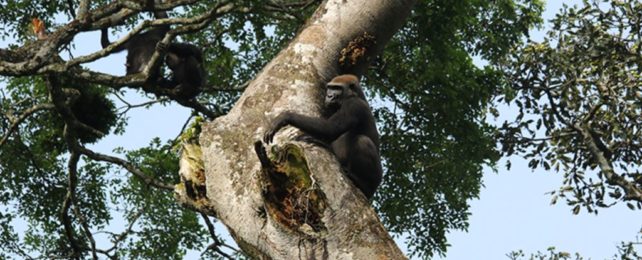Decades of patiently watching chimpanzees and gorillas in the wilds of Central Africa have revealed for the first time that long-lasting, cooperative, social relationships can develop between the two species.
Within the Goualougo Triangle – a conservation stronghold in the Republic of Congo – the two endangered animals often cross paths.
While these interactions can occasionally turn aggressive, especially on the fringes of Nouabale-Ndoki National Park, more often than not, western lowland gorillas (Gorilla gorilla gorilla) and chimpanzees (Pan troglodytes) in the 250-square-kilometer slice of forest (100-square-miles) peacefully coexist.
In fact, they seem to get along famously.
Usually, the two species will interact for about an hour. But on rare occasions, they can sometimes hang out for nearly the whole day (up to 8 hours), communally eating, chasing, wrestling, play-biting and play-hitting with one another.
One day, a researcher even caught a juvenile male gorilla mounting and thrusting on an immature female chimpanzee.
Studies on chimpanzees and gorillas elsewhere in Africa have noticed the two species interacting before, but this is the first formal documentation over such a long period of time and in such great detail.
"There are few (if any) studies of interactions between primate species that have been able to take the identity of individuals into account," says biological anthropologist Crickette Sanz from Washington University in St. Louis.
"It has long been known that these apes can recognize individual members of their own species and form long-term relationships, but we had not known that this extended to other species."
As well as doing their own research, Sanz and his colleagues also reviewed past published reports on chimps and gorillas between 1966 and 2020. They counted 33 documented interspecific interactions at eight sites in Africa.
The team's own observations were confined to the Goualougo Triangle, and from 1999 to 2020, they counted 206 interactions between chimps and local gorillas.
The results refute a commonly held hypothesis that great apes might gather together to reduce the risk of predation.
While both chimpanzees and gorillas in the study responded to each other's alarm calls, the larger chimpanzee groups were more likely to hang out with gorillas, not the smaller chimpanzee groups, which tend to be more vulnerable to predators like leopards, snakes, or raptors.
An individual chimp might even leave its group to seek out a particular gorilla individual elsewhere.
Gorillas were also observed leaving the protection of their group's silverback to gather with chimps.
The benefits must somehow outweigh the risks. Given the two species co-fed in the same tree in about a third of the observations, researchers think the perks have something to do with foraging and sharing information.
More than half of the interspecies interactions observed by scientists took place in fig trees (Ficus spp.), which are extremely rare in the conservation triangle. These trees only offer up their fruit for three or four days, which means time is of the essence.
According to researchers, when large parties of chimpanzees find a fruiting fig, they broadcast the knowledge loudly while feeding.
Interestingly, gorillas seemed to respond to these calls, sometimes changing their direction of travel to head towards the sound.
"Chimpanzees did not exhibit any similar behaviors that would indicate they were attracted to food sources by gorillas," the authors note.
"Although further research is warranted on the temporal patterning of interspecific associations at particular food resources, we suggest that gorillas may exploit chimpanzee knowledge of the location of ripe fig."
Sometimes that meant the gorillas would climb up into the fig tree along with the chimpanzees. Other times, they stayed on the ground below to feed on fallen fruit.
During these co-feeding events, young gorillas and chimpanzees would often seek out one another's company.
It's unclear why chimpanzees don't get fussed by gorillas eating their leftovers, especially from such a rare tree. But perhaps there are social benefits, like interspecific grooming, childcare, or play, that outweigh the competitive costs of a shared meal.
"No longer can we assume that an individual ape's social landscape is entirely occupied by members of their own species," says biological anthropologist Jake Funkhouser.
"The strength and persistence of social relationships that we observed between apes indicates a depth of social awareness and myriad social transmission pathways that had not previously been imagined. Such insights are critical given these interspecies social relationships have the potential to serve as transmission pathways for both beneficial socially learned cultural behaviors and harmful infectious disease."
The discovery among great apes also reveals potential interactions that might have taken place between early hominins.
Fossil records in South Africa, for instance, show that 2 million years ago there were at least three types of hominins living in a landscape no larger than the Goualougo Triangle.
It's impossible to say for sure how much the territories of these early humans might have overlapped, but the fact that some of our ancestors' closest relatives regularly play and transmit information to each other leaves open the possibility that early humans might once have done the same.
"In short, we can no longer assume that these interactions did not occur," the authors write.
It's certainly something to chew on.
The study was published in iScience.
